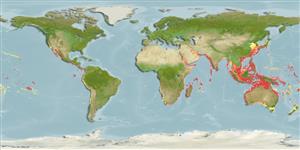Environment: milieu / climate zone / depth range / distribution range
Écologie
marin récifal; profondeur 18 - 100 m (Ref. 11441). Tropical; 40°N - 40°S, 16°E - 124°W
Indo-West Pacific (Ref. 4919). Lessepsian migrant to the Mediterranean Sea (Ref. 55043).
Length at first maturity / Taille / Poids / Âge
Maturity: Lm 43.3 range ? - ? cm
Max length : 110 cm TL mâle / non sexé; (Ref. 125962); common length : 40.0 cm TL mâle / non sexé; (Ref. 5450); poids max. publié: 9.0 kg (Ref. 125962)
Épines dorsales (Total): 0; Rayons mous dorsaux (Total): 10-13; Épines anales 0; Rayons mous anaux: 8 - 12. Greenish with brown or black spots above; silver band from mouth to caudal fin; belly white; silver blotch in front of eye; pectoral base black (Ref. 4919).
Inhabits offshore reefs (Ref. 9563). Sandy bottom (Ref. 95646). Caught by trammel net (Ref. 96695). This species contains tetrodotoxin which may be a source for food poisoning and the Israel Poison Information center registered 13 cases in December 2008 where all were related to the consumption of this fish (Ref. 118670).
Life cycle and mating behavior
Maturité | Reproduction | Frai | Œufs | Fécondité | Larves
Masuda, H., K. Amaoka, C. Araga, T. Uyeno and T. Yoshino, 1984. The fishes of the Japanese Archipelago. Vol. 1. Tokai University Press, Tokyo, Japan. 437 p. (text). (Ref. 559)
Statut dans la liste rouge de l'IUCN (Ref. 130435)
Menace pour l'homme
Poisonous to eat (Ref. 559)
Utilisations par l'homme
Pêcheries: sans intérêt; Aquarium: Commercial
Plus d'informations
RéférencesAquacultureProfil d'aquacultureSouchesGénétiqueElectrophoresesHéritabilitéPathologiesTraitementNutrientsMass conversion
Outils
Articles particuliers
Télécharger en XML
Sources Internet
Estimates based on models
Preferred temperature (Ref.
123201): 21.6 - 28.6, mean 27.3 °C (based on 762 cells).
Phylogenetic diversity index (Ref.
82804): PD
50 = 0.5005 [Uniqueness, from 0.5 = low to 2.0 = high].
Bayesian length-weight: a=0.01349 (0.01114 - 0.01633), b=2.87 (2.81 - 2.93), in cm total length, based on LWR estimates for this species (Ref.
93245).
Niveau trophique (Ref.
69278): 3.7 ±0.4 se; based on diet studies.
Résilience (Ref.
120179): Milieu, temps minimum de doublement de population : 1,4 à 4,4 années (tmax=7; tm=3; K=0.099-0.3;).
Fishing Vulnerability (Ref.
59153): Moderate vulnerability (40 of 100).
Nutrients (Ref.
124155): Calcium = 18.1 [7.7, 40.9] mg/100g; Iron = 0.452 [0.237, 0.911] mg/100g; Protein = 18.9 [16.7, 21.1] %; Omega3 = 0.128 [0.060, 0.249] g/100g; Selenium = 50.1 [26.9, 98.3] μg/100g; VitaminA = 53.4 [20.0, 144.7] μg/100g; Zinc = 0.9 [0.6, 1.3] mg/100g (wet weight);
